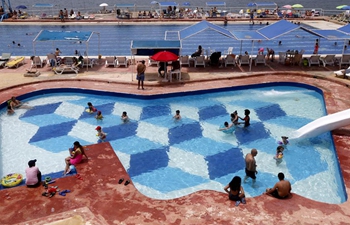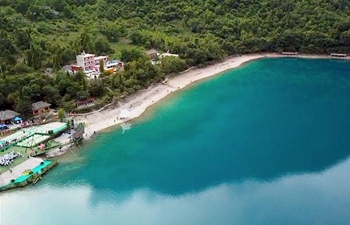JARDINES DEL REY, CUBA, June 16 (Xinhua) -- "It was like a war, but without casualties," Lessner Gomez said when recalling the passage of Hurricane Irma last September as it battered the archipelago of Jardines del Rey off the northern coast of Cuba.
The representative of the Ministry of Tourism (MINTUR) in the central province of Ciego de Avila admitted his anguish as the storm affected every facility in the Coco and Guillermo islands, both part of the archipelago.
Today, however, the two small islands have fully recovered after rapid work by Cuban agencies to restore the highly popular tourism destination.
Irma hit the area on Sept. 9, but its tourism venues were ready to go on Oct. 28, having been fully repaired.
"The hotels were damaged mainly on the roofs, furniture and windows. The beach bars and restaurants were practically destroyed by the sea, but today you can see another image altogether," said Gomez with pride.
By November, all 16 hotels in Jardines del Rey were occupied by thousands of holidaymakers, who witnessed the rebirth of the tourist destination.
Jardines del Rey, or King's Gardens, takes its name from King Fernando II of Aragon, after whom the area was named by Spanish conquistador Diego Velazquez in 1514.
It is alleged that Velazquez was seeking the favor of the King since, four years earlier, Christopher Columbus had named another charming archipelago, Queen's Gardens.
The Coco and Guillermo keys alone have 18 beaches, covering more than 36 kilometers, and their coastal dune is the highest in the Caribbean, reaching up to 16 meters in some places.
A few months ago, the local beaches benefited from a makeover, with a fresh load of sand being placed there at a cost of over 8 million U.S. dollars.
The area receives thousands of migratory birds every year and has a coral reef considered one of the finest in the world, helping to draw tourists with its biodiversity.
As a tourist destination for the last 25 years, the keys are included in an ambitious development program. This plan aims to triple the 7,000 rooms in the archipelago and allow it to welcome 500,000 visitors a year.
"We can be one of the most important national tourist destinations," said Eduardo Veiga, a university professor involved in the area's growth plans.
Some of the largest international hotel chains, such as Melia Hotels International, Iberostar, Pestana, and Acor are present there, along with the Cuban hotel companies Gran Caribe and Cubanacan, among others.
The development strategy of the small archipelago plans to build up to 43 hotels, a limit established to grow tourism in a "friendly" way alongside its pristine environment.
"Jardines del Rey is not just about the sunshine and the beach; it's also about history and nature. Today, the tourist destination has better conditions to face the high season. We want people to take away good memories of their stay with us," said Gomez.
















